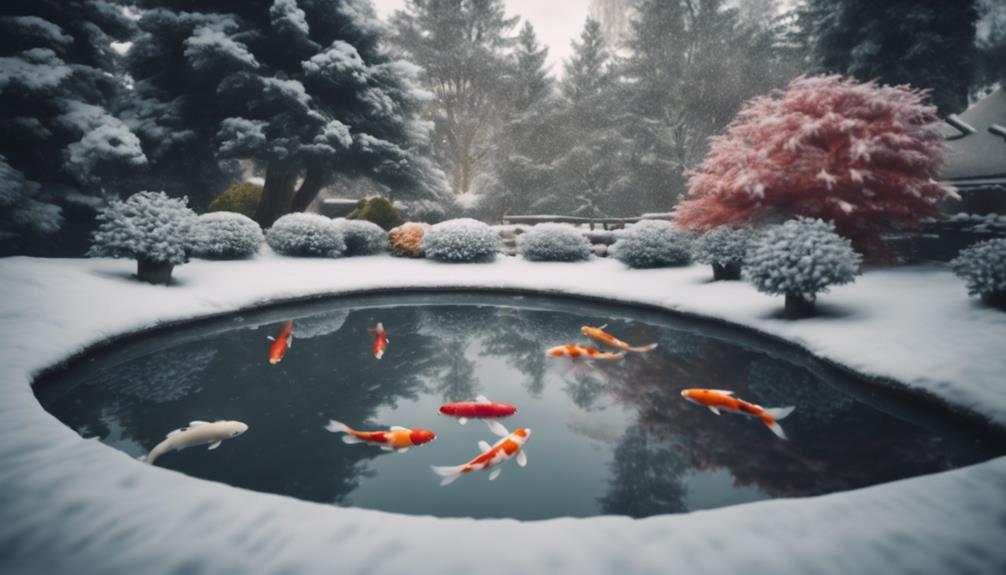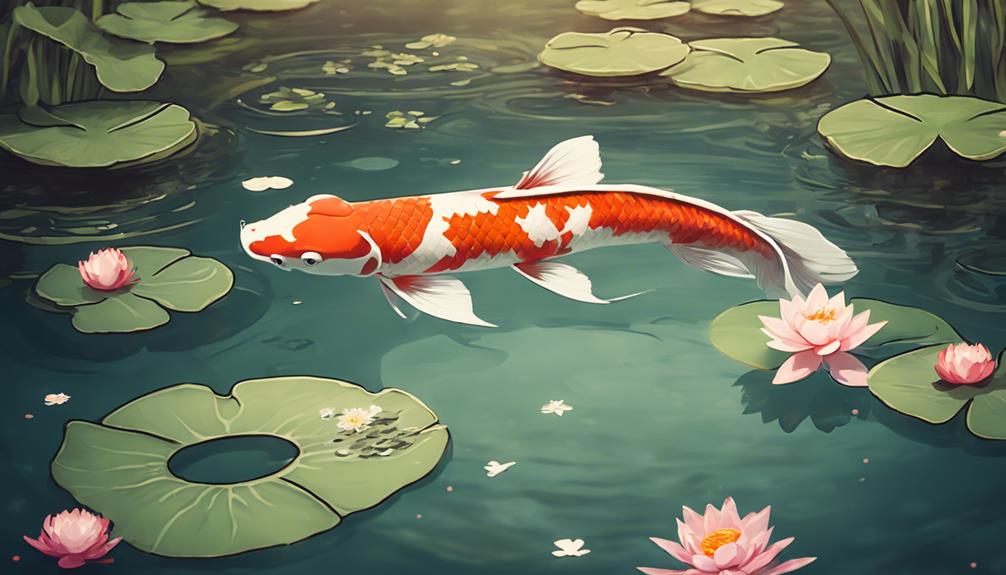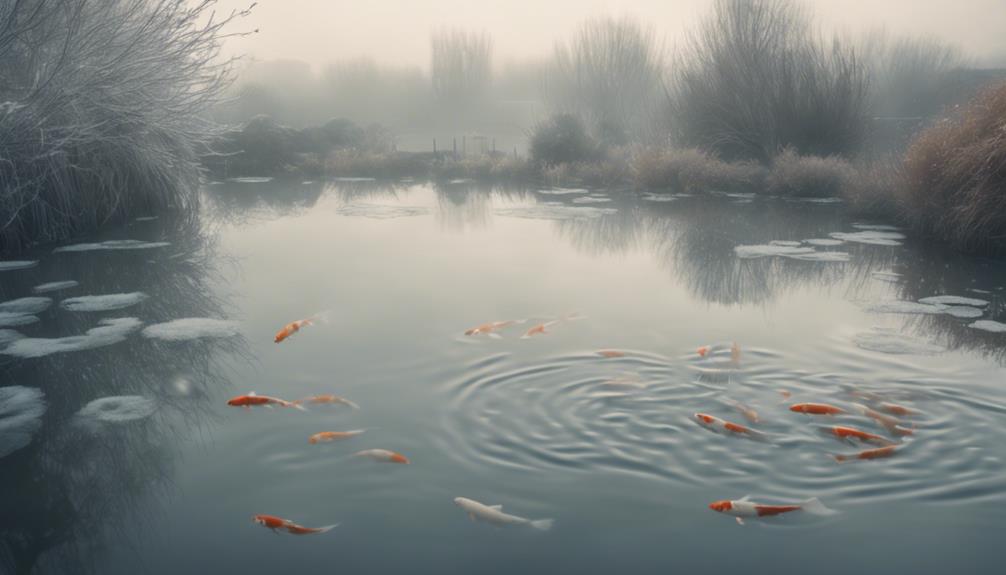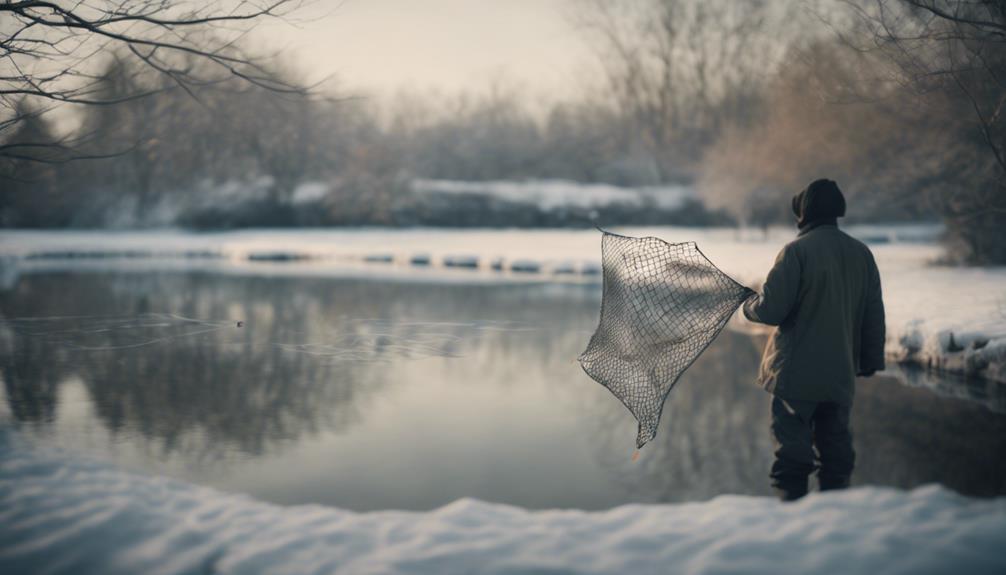As a koi owner, you know that winterizing your pond is vital to guarantee the survival and health of your fish. To prevent breeding, you'll want to understand koi spawning triggers and behavior, including factors like water temperature and hormonal signals. Implement effective breeding prevention strategies, like separating males and females, to maintain a balanced population. Properly winterize your koi fry, guaranteeing they're at least 1.5 inches long before winter, and provide a safe haven with adequate space and insulation. By following these techniques, you'll be well on your way to a thriving and healthy koi population – and there's more to explore.
Table of Contents
Key Takeaways
- Stop feeding koi when water temperature drops below 50°F to prevent digestive issues and ensure their safety during winter.
- Implement breeding prevention strategies to maintain a balanced koi population and prevent overcrowding, water quality issues, and ecosystem disruption.
- Winterize the pond by taking steps to prepare it for cold weather, including adding a pond heater or aerator, and ensuring the pump is winter-ready.
- Provide a safe haven for koi fry, free from harsh winter conditions, and maintain a water temperature above 39°F (4°C) to increase their survival chances.
- Regularly remove leaves and debris from the pond and skimmers to prevent ammonia build-up, pump clogging, and leaks, which can compromise water quality.
Preparing Your Pond for Winter
As you prepare your pond for the harsh winter months, start by taking proactive measures to safeguard your koi and maintain a healthy aquatic environment.
One vital step in winter pond care is to install fish pond netting to protect your koi from predators and keep leaves and debris out of the pond.
Regularly remove leaves and debris to prevent ammonia build-up, pump clogging, and leaks, and to maintain water quality.
Next, trim and remove dead or dying foliage from pond plants to improve the pond's appearance and your koi's health, while also preventing the spread of disease.
By taking these steps, you'll create a safe and thriving environment for your koi to survive the winter.
Maintaining Water Quality During Winter
You can now turn your attention to maintaining water quality during winter, a vital component of winter pond care that requires careful consideration.
As the water temperature drops, you'll need to switch to cold water bacteria to break down organic matter and oxygenate the water. Use a product specifically designed for water temperatures below 50°F and add the recommended amount to the pond on a weekly basis. Monitor the water temperature and adjust bacteria application accordingly, as it affects the bacteria's effectiveness.
Proper circulation and aeration are also essential to prevent stagnation and maintain water quality, especially during winter when koi are dormant. Regularly remove leaves and debris from the pond and skimmers to prevent ammonia build-up, pump clogging, and leaks, which can compromise water quality.
Caring for Your Koi During Winter

Stop feeding your koi once the water temperature drops below 50°F, as their metabolism slows down and they're unable to digest food properly. This is vital to prevent digestive issues and reduce waste production, which can lead to water quality problems.
As winter approaches, you'll want to focus on keeping your pond clean and well-maintained to safeguard your koi's health and survival.
Monitor water temperature: Regularly check the temperature to safeguard it doesn't drop too low, causing stress to your koi.
Provide adequate oxygen: Make sure your pond has sufficient aeration to keep the water oxygenated, especially during the winter months.
Winterize your pond: Take steps to prepare your pond for the cold weather, such as adding a pond heater or aerator, and making sure your pump is winter-ready.
Winterizing Koi Fry and Breeding Prevention
As you prepare your koi for winter, don't forget to prioritize the special needs of your koi fry.
You'll need to take specific steps to guarantee their survival, and understanding fry growth factors can help you optimize their winter hardiness.
Fry Winterization Methods
Winterizing koi fry requires careful planning and attention to detail to guarantee their survival, particularly since they're more vulnerable to temperature fluctuations than adult koi. As a responsible koi breeder, you want to certify that your koi fry make it through the winter months healthy and thriving.
To increase their chances of survival, make sure your koi fry are at least 1.5 inches long before winterizing them. A 350-gallon stock tank provides adequate space and insulation for wintering fry. Additionally, filtration and aeration are essential for maintaining water quality and preventing disease during fry winterization.
Be prepared to provide a safe haven for your koi fry, free from harsh winter conditions. Give your koi fry the best chance at survival by maintaining a water temperature above 39°F (4°C). Take pride in knowing you're taking the necessary steps to protect your koi fry from the cold, harsh winter.
Koi Breeding Prevention
How do you prevent your koi from breeding during the winter months when their metabolism slows down, making them more susceptible to disease and stress?
One effective method is to separate your koi by sex. This can be a challenge, as it's difficult to determine the sex of immature koi. However, you can try to identify the sex of your koi by looking for subtle differences in their vent area or by performing a gentle pressure test on their abdomen.
Another approach is to keep your koi in a crowded pond, as this can suppress koi breeding. You can also try to maintain a consistent water temperature between 40°F and 50°F, as this can slow down koi breeding.
Additionally, reduce your koi's food intake during the winter months, as excess nutrients can stimulate breeding. By taking these steps, you can prevent unwanted koi breeding and reduce the risk of disease and stress in your pond.
Fry Growth Factors
When it comes to winterizing koi fry, you'll want to focus on optimizing growth factors to guarantee their survival, as fry that are at least 1.5 inches long are more likely to thrive in cold temperatures. This critical size threshold certifies they can withstand the harsh winter conditions.
To promote healthy growth, you'll need to provide a suitable environment, including a spacious tank with adequate water quality. A 350-gallon stock tank is a good starting point.
Certify your koi fry are well-fed and healthy, as this will directly impact their ability to survive the winter.
Monitor their growth rate, as faster-growing fry tend to be more resilient to cold temperatures.
Remove weak or sick individuals to prevent the spread of disease and maintain a strong, thriving population.
Understanding Koi Spawning Triggers and Behavior

As a koi owner, you're likely aware that understanding the triggers and behavior surrounding koi spawning is crucial for maintaining a healthy and balanced aquatic environment.
Koi spawning can be triggered by various factors, including changes in water temperature, lighting, and other environmental factors. Rough contact between koi can also stimulate females to lay eggs, and hormonal signals from males can trigger spawning.
Notably, females can lay eggs without males present, but this can lead to a decrease in water quality if left unchecked.
It's essential to recognize that koi can spawn repeatedly in a short period, with some owners reporting 4-5 spawns in a short time. Spawning can occur at night, making it challenging to detect.
Conditioning, lighting amount and spectrum, and stimulus such as moon, rain, and water changes can all trigger spawning. By understanding these triggers and behaviors, you can take steps to manage and control breeding in your pond.
Separating males and females into different ponds is one effective way to prevent breeding. By being aware of these factors, you can guarantee a healthy and thriving koi population.
Preventing Koi Breeding and Pond Management
By implementing effective breeding prevention strategies and proper pond management techniques, you can maintain a balanced and thriving koi population while minimizing the risk of overcrowding and water quality issues.
As a responsible koi owner, taking proactive steps to prevent excessive breeding is imperative, which can lead to water quality degradation and stress on your fish.
Some pivotal reasons why preventing koi breeding is necessary for your pond's ecosystem:
- Overcrowding chaos: Excessive breeding can lead to overcrowding, causing stress, disease, and even death among your koi.
- Water quality woes: The increased biological load from excessive breeding can lead to water quality issues, such as ammonia and nitrite spikes, which can harm your fish.
- Unbalanced ecosystem: Uncontrolled breeding can disrupt the delicate balance of your koi pond's ecosystem, leading to an explosion of algae growth and other unwanted consequences.
Koi Breeding Experiences and Observations

As you explore koi breeding, you'll want to understand the factors that influence breeding success.
Observe spawning behavior, and address issues with roe-bound females.
You've likely noticed that koi breeding can be unpredictable, with some owners reporting multiple spawns in a short period while others experience none at all.
Breeding Success Factors
Your koi's breeding success hinges on understanding the intricacies of their spawning behavior, which can be influenced by a multitude of factors. As you explore the world of koi breeding, recognizing that these factors can make or break your breeding attempts is vital.
You might be surprised to learn that koi can spawn repeatedly in a short time frame, with some owners reporting 4-5 spawns in a row. Additionally, females can lay unfertilized eggs even without males present, highlighting the complexity of koi breeding behavior. Furthermore, koi can spawn in small tanks or containers, making it pivotal to separate males and females to prevent breeding.
You could be unwittingly condemning your koi to death if they don't spawn, as they can become 'roe-bound' and die if they don't release their eggs.
You might be waiting in vain for spawns that never come, as some koi owners have reported having mixed-sex koi with no breeding success.
You could be overlooking critical factors that influence breeding success, leading to disappointing results.
Spawning Behavior Observed
Observations of koi spawning behavior have led many breeders to conclude that these fish exhibit complex and intriguing reproductive patterns. You may have noticed that koi can spawn repeatedly in a short period, with some owners reporting 4-5 spawns in a short time frame. Additionally, females can lay unfertilized eggs even without males present, which can occur in small tanks or containers.
| Spawning Behavior | Frequency | Conditions |
|---|---|---|
| Repeated Spawning | 4-5 times | Short time frame |
| Unfertilized Eggs | Without males | Small tanks/containers |
| Nighttime Spawning | Difficult to detect | Regular pond monitoring |
| Roe-Bound Females | Can be fatal | Proper pond management |
| Mixed-Sex Koi | No spawns reported | Various factors influence |
As you observe your koi's spawning behavior, keep in mind that it can occur at night, making it vital to regularly monitor and maintain your pond. Remember, proper pond management and breeding prevention methods are essential to prevent koi from becoming 'roe-bound' and potentially dying. By understanding these complex reproductive patterns, you can better care for your koi and create a thriving environment.
Roe-Bound Female Issues
When dealing with roe-bound females, it's crucial to recognize the warning signs, such as a swollen abdomen, lethargy, and loss of appetite, to prevent potentially fatal complications.
As a koi breeder or pond owner, it's imperative to identify these issues early on to safeguard the health and well-being of your fish.
Roe-bound females can be a significant concern, leading to water quality issues, unwanted breeding, and even death if left untreated.
To prevent these problems, you can try to induce spawning in females or separate them from males to prevent unwanted breeding.
You watch your beautiful koi slowly succumb to the effects of being roe-bound, knowing you could've prevented it.
You're left dealing with the consequences of poor water quality, caused by unfertilized eggs released by roe-bound females.
You're forced to make the difficult decision to euthanize a beloved fish due to severe roe-bound complications.
Effective Winterization Methods and Tips
By implementing a few crucial winterization methods, you can guarantee your koi's health and safety during the cold months.
First, install fish pond netting to protect your koi from predators and keep leaves and debris out of the pond. Regularly remove leaves and debris to prevent ammonia build-up, pump clogging, and leaks.
Next, switch to cold water bacteria specifically designed for water temperatures below 50°F to break down organic matter and oxygenate the water.
Trim and remove dead or dying foliage from pond plants to improve pond appearance and fish health. Cut back hardy waterlilies just above the base of the plant.
Leave your pond running to maintain water quality and prevent stagnation, certifying proper circulation and aeration.
Finally, monitor water temperature and adjust bacteria application accordingly, using a pond thermometer to regularly check the pond's temperature.
Frequently Asked Questions
How Do You Winterize Koi Fish?
When winterizing koi fish, you'll want to focus on gradual Koi Acclimation, slowly introducing them to cooler temperatures to prevent shock, and providing a safe, well-oxygenated environment to thrive during the cold months.
When Should I Close My Koi Pond for Winter?
As winter's chill descends, you'll know it's time to close your koi pond when the water temperature consistently stays below 40°F. Guarantee proper pond insulation to prevent freezing, and follow the necessary steps to safeguard your fish's winter slumber.
When Should You Stop Feeding Koi for the Winter?
You should stop feeding your koi when the water temperature drops below 50°F (10°C) to prevent digestive issues, Fatty Liver disease, and promote a healthy hibernation period, ensuring their survival and well-being during the winter months.
How Deep Does a Pond Need to Be for Koi to Survive the Winter?
You've seen it happen: a shallow pond in Minnesota freezes solid, killing all the koi. To avoid this, you'll want a pond depth of at least 3-4 feet to guarantee your koi survive the winter.
Conclusion
As you wrap up winterizing your koi, remember that 'an ounce of prevention is worth a pound of cure.'
By following these 10 breeding techniques, you'll prevent unwanted spawning, maintain water quality, and guarantee your koi thrive during the cold months.
With a well-prepared pond and informed care, you'll be enjoying your vibrant, healthy koi come spring.

